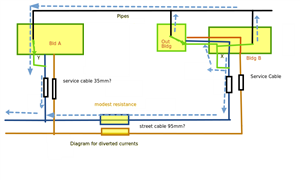OlympusMons:Graham Warner:
it's quite possible (but impossible to check) that the water mains to each of the 3 buildings concerned might be in iron pipes.
you could do continuity tests on the pipes with a wander lead to check.
Quite so - but the impossibility lies in the elimination of all parallel paths in a safe manner, at least without shutting down the whole site, which is not feasible.
GW.
Quite so - but the impossibility lies in the elimination of all parallel paths in a safe manner, at least without shutting down the whole site, which is not feasible.
Yes, the CPC in a distribution circuit to another building must be at least as big as a MPBC, but does it ever need to be bigger than the earthing conductor of the whole installation?

but apparently with a contractual obligation that we continue to supply the juice to their changing room/showers/water treatment kit etc.
We're about to take you to the IET registration website. Don't worry though, you'll be sent straight back to the community after completing the registration.
Continue to the IET registration site